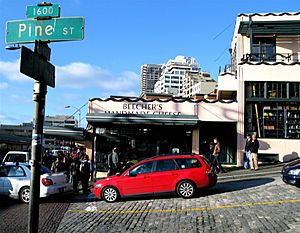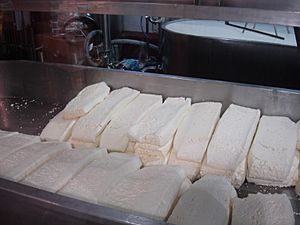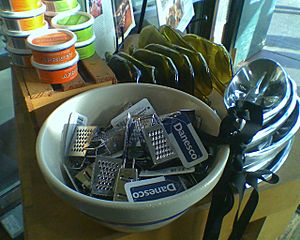Beecher's Handmade Cheese facts for kids
 |
|
| Private | |
| Industry | Cheese |
| Founded | 2003 |
| Headquarters |
Seattle, Washington
,
|
| Owner | Kurt Beecher Dammeier |
Beecher's Handmade Cheese is a company that makes special, high-quality cheese. They have stores in the Seattle area and at some airports. Kurt Beecher Dammeier started the company in 2003. He opened the first store in Pike Place Market in Seattle. This was a big deal because it's hard to get a spot there!
Kurt Dammeier wasn't a cheesemaker himself. So, he asked Brad Sinko for help. Brad came from a family that made cheese in Oregon. In 2011, Beecher's opened a second store in Manhattan, New York. However, this location closed in October 2022.
Unlike many small cheese makers, Beecher's uses milk that has been pasteurized. This means the milk is heated to kill germs. They also have a large, modern factory. Many farms supply milk to Beecher's. Sometimes, they had trouble getting milk that tasted the same every time. To fix this, Beecher's bought their own dairy cattle and farms. This way, they could control the cheese-making process from start to finish. Beecher's also uses different types of cultures when mixing cheeses. This means their cheddar cheese might have a unique flavor.
The Beecher's store in Pike Place Market has a cafe. You can buy grilled cheese sandwiches and other tasty foods there. They also have a shop that sells Beecher's cheeses and cheeses from other local companies. Beecher's also makes and sells macaroni and cheese dishes. These frozen meals have been praised by news channels across the country. Kurt Dammeier and his cheeses have even been on TV shows like The Martha Stewart Show and Oprah. Oprah called their "World's Best" Macaroni and Cheese one of her "Favorite Things."
Kurt Dammeier also wrote a cookbook called Pure Flavor: 125 Fresh All-American Recipes From The Pacific Northwest. It includes recipes for some of Beecher's products. Besides making cheese, Beecher's helps fund the Flagship foundation. They also support the Pure Food Kids project. This program teaches children in Seattle public schools about eating healthy.
Contents
How Beecher's Cheese Started
Before starting Beecher's, Kurt Dammeier had never made cheese. He didn't know much about the business. But he loved cheese since he was a kid in Tacoma, Washington. His family always had a big cheese board. Kurt grew up in a family business that involved printing and making food. After his family sold the printing company, he decided to open a cheese business. He named it after his great-grandfather, Beecher McKenzie.
Kurt Dammeier also owns a special grocery store in Seattle called Pasta & Co. He is also a big investor in Pyramid Breweries. Other family members are involved with Pyramid too. Dammeier also started Bennett's Pure Food Bistro on Mercer Island. He also created the food truck Maximus/Minimus. Both of these places use many Beecher's cheese products.
In 2003, Beecher's opened in Seattle's Pike Place Market. A large store space became available there. This happened after a plant nursery called Molbak's moved to a new location.
After taking a cheese-making class, Dammeier knew he needed a head cheesemaker. He hired Brad Sinko, who was a microbiologist. Brad used to manage his family's cheese business in Oregon. It was called Bandon Cheese. Kurt Dammeier felt that Seattle and Washington didn't have enough special cheese makers. He wanted his business to help more cheese companies grow in the area. In 2000, Washington had only nine licensed cheesemakers. By 2007, this number grew to twenty-eight.
Dammeier compared the growth of special cheese to how craft beers became popular. He said that in the future, people would know more about different types of cheese.
Beecher's was able to grow slowly because of money from Dammeier's other businesses. This allowed them to try out different cheeses. They could also take the time needed to age them. Dammeier said, "The first vat [of cheese], we threw away. The second vat was really good." As they learned, Brad Sinko changed the recipes. He adjusted the cultures and enzymes they used. They also started aging their Flagship cheese for 18 months. But they only tell people it's aged for 12 months. In their first year, Beecher's didn't have any aged cheese to sell. Instead, they saved up about 80,000 pounds (36,287 kg) of cheese. During that time, they mainly sold fresh cheese curds.
Where Beecher's Gets Its Milk
When Beecher's first started, they had one milk supplier. But they grew and needed more milk. So, they added more suppliers. Around 2006, Beecher's started buying their own farms in Eastern Washington. This would give them even more milk. It also gave them full control over how their cheese was made.
Their main milk supplier is Green Acres Farm in Duvall, Washington. This farm uses milk that is free of hormones and antibiotics. When they first had problems getting enough milk, Beecher's bought a herd of 200 cows. Beecher's now owns all the dairy cows at Green Acres Farm. They lease them back to the farm. For their New York cheese, all the milk comes from Dutch Hollow Farms in upstate New York. This milk is from Holstein and Jersey cows.
To make sure the cheese always tastes the same, Brad Sinko "standardized the herd." This means he made sure the cows produced milk with a consistent flavor. Their first milk from Holstein cows was sweet. But it didn't have the rich, nutty taste of Jersey cow milk. This nutty taste was important for the cheese they wanted to make. They eventually found a good balance between the two types of milk. Dammeier said it's a "50–50 mix." All the milk from each farm comes from the same group of cows. This helps keep the flavor of each batch of milk consistent. The cows' diet and environment affect the milk's flavor.
Sometimes, Beecher's faced challenges keeping this standard. For example, when a farm had floods, the cows' milk changed. It produced enzymes that helped their calves fight bacteria. But this also changed the flavor of the milk.
How Beecher's Makes Cheese and Food
The cheese factory is in a small building with glass walls. It's located in Pike Place Market. This spot includes a store and a cafe that serves cheese-based meals. People walking by can watch the cheese being made. Beecher's makes over 500,000 pounds (226,796 kg) of cheese every year. Their factory now runs 24 hours a day to keep up with demand. The New York factory is much bigger. It can make over three tons of cheese a day.
Brad Sinko knows that a modern factory with large vats might seem to go against the name "Handmade." But he says that all the cheese is still watched, processed, and prepared by hand. It's just done on a larger scale than most small cheese makers. Unlike most special cheeses, Beecher's uses mostly pasteurized milk. Dammeier believes that many people think raw milk cheeses taste better. This is because famous French cheeses were historically made with raw milk. But that was because farms couldn't afford pasteurization. Dammeier said he has tasted many cheeses. He believes raw milk doesn't create more flavor. He also said his cheeses have a more consistent taste because they don't use raw milk. However, Beecher's does offer a raw milk version of their Flagship cheese. Their cheeses have no fake ingredients or preservatives. Beecher's usually makes up to nine different kinds of cheeses each year. These include their main brands and some seasonal ones.
At Beecher's, making cheese involves many steps. Thousands of gallons of milk are pumped from trucks into the factory. There, it is heated to pasteurize it. The heated milk goes into a stainless steel trough. The temperature is raised even more. Then, the first cheese cultures and rennet are added. Rennet helps the milk thicken. A cheesemaker at Beecher's, Amir Rosenblatt, said that the heating and cheese temperatures are carefully controlled. They use steam power. He said that even a tiny change in temperature can change the cheese's flavor.
Cheesemakers use special "rakes" to gather the milk mixture. Then they let it sit for a short time. After that, the cheese is cut many times by hand. It becomes like a thick yogurt. This cutting is repeated until the cheese has the right texture. The mixture is then moved to a new trough. Most of the water and whey is drained from the cheese. As the whey is removed, cheesemakers keep separating the cheese by hand into smaller piles of cheese curds. To finish the curding, a lot of salt is added. This helps to cure the cheese and remove even more whey.
Finally, the curds are cut into pieces. They are put into cheese molds and stacked. The extra moisture is squeezed out with 60 pounds (27 kg) of pressure for at least 24 hours. Then the finished cheese is stored to age. For every 10 pounds (4.5 kg) of milk and whey, Beecher's usually makes 1 pound (0.45 kg) of finished cheese.
Beecher's cheeses are special because they mix cheese cultures in unusual ways. For example, their main "Flagship" cheese uses cultures usually found in non-cheddar cheeses. These include Gruyère and Emmental. This changes the taste and texture of their cheddar-style cheese. Flagship cheese is made using a cheddaring process. But because it tastes different, Beecher's doesn't call it cheddar. People say this cheese has a "sweet finish and creamy texture." This is because of the mix of different cheese cultures.
After being made into 40-pound (18 kg) blocks, Flagship cheese is aged for about one year. Unlike cheddars, it doesn't have a rind. It's also moister and looks like butter. It has a milky smell because it's aged in plastic bags. A special version called "Flagship Reserve" is aged in cheesecloth. It's aged in 18-pound (8 kg) sizes on racks in the open air. It's rubbed with butter and turned every day. This way of making it causes the Reserve to lose up to 12% of its weight. The Reserve is aged for a shorter time. This gives it a sharper, nuttier taste and texture, according to Food & Wine Magazine. Of the 500,000 pounds (226,796 kg) of cheese they make each year, about 200,000 pounds (90,718 kg) is Flagship. Only about 15,000 pounds (6,804 kg) is Flagship Reserve.
Beecher's is also working on new types of crackers. These crackers are designed not to overpower the taste of the cheese.
Beecher's Stores and Cheese Shop
Beecher's has a fancy cheese shop and cafe in their Pike Place Market location. It's a very important part of the market and a popular place for tourists. During the day, many people gather in the store. They watch through windows as the cheesemakers prepare cheese.
Some of the fresh cheese curds are set aside to sell directly to visitors. The main cheeses Beecher's makes and sells are Flagship and Flagship Reserve. They also sell "Just Jack," which is a type of Monterey Jack cheese. "Blank Slate" is a type of cream cheese. They also have raw-milk versions of their Flagship cheeses. And they sell different cheeses flavored with spices and herbs. Some of their seasonal cheeses have been similar to Brie.
The Pike Place Market store now sells about 35 other local special cheese brands. They also sell all the Beecher's products. The Pike Place Market location also offers classes to the public. These classes teach about making cheese, cheese history, and pairing wine with cheese. A magazine called Northwest Magazine said that the collection of Pacific Northwest cheeses at the store is the best in the whole region. Beecher's tries to feature and sell cheeses from new and small Northwest cheesemakers. This helps other cheese businesses grow, which was Kurt Dammeier's idea.
Beecher's also has other locations in the Puget Sound area. These include a store at the Bellevue Square shopping center. They also have stores at Seattle–Tacoma International Airport and Paine Field in Everett. The company's stores let you order food using their own app on your phone.
Beecher's products are sold in stores across the country. These include famous cheese shops like Murray Klein's and Artisanal Cheese. Beecher's also uses a service called PeriShip. This helps make sure their products get to customers all over the United States.
Beecher's Macaroni and Cheese
Beecher's store in Pike Place Market sells over 17,000 orders of Kurt Dammeier's macaroni and cheese every year. The recipe is in a 2007 cookbook called Pure Flavor: 125 Fresh All-American Recipes From The Pacific Northwest. Kurt Dammeier wrote it with Laura Holmes Haddad. Both The New York Times and The Washington Post gave it great reviews.
Dammeier says the secret to their macaroni and cheese is to undercook the pasta. This way, it softens perfectly from the cheese sauces when it bakes. They use a creamy béchamel sauce. The recipe is simply called "World's Best Mac & Cheese." Dammeier has made it on several TV shows. On August 19, 2008, Beecher's and its cheese were shown on The Martha Stewart Show. Dammeier made his macaroni and cheese with Martha Stewart on the show. The "World's Best Mac & Cheese" was also one of Oprah's "Favorite Things." It was also featured a second time on "The Martha Stewart Show."
Awards and Recognition
In 2007, Beecher's won awards from the American Cheese Society for their cheddar cheese. At the World Cheese Awards in 2007, Beecher's "Marco Polo" cheese won a gold medal. They also took first place at the American Cheesemaker Awards in Newport Beach, California, also in 2007. Beecher's was also the runner-up for Best In Show at the 2007 World Cheese Society competition. There were 1,207 other competitors. Beecher's won another top award from the American Cheese Society for their Marco Polo cheese in 2008. Laura Werlin, who wrote a book about American cheesemakers, said their Flagship cheese is "everything a cheddar should be - and more."
Pure Food Kids Program
Beecher's and Kurt Dammeier also help fund and create "Pure Food Kids: A Recipe for Healthy Eating." This is a program for elementary and middle-school children in the Seattle Public Schools. Its goal is to teach kids about healthy foods and eating habits. Kurt Dammeier and his wife Leslie first developed the program. They were unhappy with the school cafeteria meals in Seattle, where their three children went to school.
The program started in 2005. One percent of all sales from Beecher's and Dammeier's other businesses help fund the Pure Food Kids program. These businesses include Bennet's Pure Food, Maximus/Minimus, and Pasta & Co. The Pure Food Kids program has trained volunteers, including Dammeier himself.
Children in fourth through sixth grade learn about the effects of food additives. They also learn about eating healthy foods, reading food labels, and how food is marketed to kids. These children are usually between 9 and 12 years old. The program is free for children and their families. So far, over 15,000 children have taken part in the program. Pure Food Kids is taught in classrooms, after-school events, and at Parent-Teacher Association events. All supplies and materials are provided by Beecher's. However, they do not promote or use any products from Dammeier's businesses in the program.
See also
- Cougar Gold cheese
- List of cheesemakers
- List of restaurants in Pike Place Market





